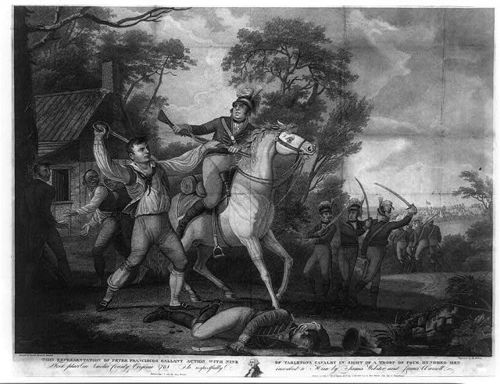Annotation:Peter Francisco
X:1 T:Peter Francisco M:C| L:1/8 K:D FE|D2D2 DFAB|=c2 cA GEC2|D2D2D2 FA|dfec d2:| |:d2|dcde fefg|a2af gfe2|dcde fefg|agab a3e| dcde fefg|a2af gfe2|d2dc d2AG|FDEF D2:||

After hostilities broke out with England, Francisco at the age of 16 received Winston’s consent to enlist in the 10th Virginia Regiment as a private. He subsequently fought at Brandywine (where he was wounded), Germantown, Fort Mifflin, Monmouth (where he was again wounded), and Stony Point (wounded a third time). His three year enlistment being up in 1779, Francisco returned to Virginia. Soon, however, the active portion of the war shifted South, and Francisco joined Continental forces in the Carolinas, fighting in the disatrous defeat of the Battle of Camden under Gates, and the more successful action at Guilford Courthouse with Greene. He became the most famous enlisted man of the war. Benson Lossing reported in his 1850 Pictorial Field Book of the Revolution, that Francisco, "a brave Virginian, cut down eleven men in succession with his broadsword. One of the guards pinned Francisco's leg to his horse with a bayonet. Forbearing to strike, he assisted the assailant to draw his bayonet forth, when, with terrible force, he brought down his broadsword and cleft the poor fellow's head to his shoulders!"
Francisco was wounded a total of five times, but survived to attended the British defeat at Yorktown. After the war he worked as a blacksmith and continued his education, marrying several times after the death of each wife and fathering several children. In 1825 he was made Sergeant-at-Arms for the Virginia Legislature. He passed away on January 16, 1831. His shoes are preserved to this day at the Guilford Courthouse Battlefield, near Greensboro, N.C. (Fuzzy Mtn. String Band). Chris Goertzen, in his book George P. Knauff's Virginia Reels and the History of American Fiddling (2017, p. 61), points out that after the war Francisco lived in Buckingham County, Virginia, and ran a tavern in New Store, about fifteen miles from Virginia Reels editor George P. Knauff's home in Farmdale, Virginia, and only six or seven miles from where Knauff taught for a time at a women's preparatory school. Goertzen says that Francisco was thus a local hero, whose reputation remained strong in the region.

